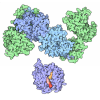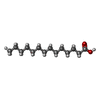[English] 日本語
 Yorodumi
Yorodumi- PDB-7ell: In situ structure of capping enzyme lambda2, penetration protein ... -
+ Open data
Open data
- Basic information
Basic information
| Entry | Database: PDB / ID: 7ell | |||||||||||||||||||||||||||
|---|---|---|---|---|---|---|---|---|---|---|---|---|---|---|---|---|---|---|---|---|---|---|---|---|---|---|---|---|
| Title | In situ structure of capping enzyme lambda2, penetration protein mu1 of mammalian reovirus capsid asymmetric unit. | |||||||||||||||||||||||||||
 Components Components |
| |||||||||||||||||||||||||||
 Keywords Keywords | VIRAL PROTEIN/TRANSFERASE / mammalian reovirus 3 / capping enzyme lambda2 / penetration protein mu1 / VIRUS / VIRAL PROTEIN-TRANSFERASE complex | |||||||||||||||||||||||||||
| Function / homology |  Function and homology information Function and homology informationhost cell surface binding / viral outer capsid / symbiont entry into host cell via permeabilization of host membrane / mRNA guanylyltransferase activity / mRNA guanylyltransferase / mRNA (guanine-N7)-methyltransferase / mRNA 5'-cap (guanine-N7-)-methyltransferase activity / GTP binding / ATP binding Similarity search - Function | |||||||||||||||||||||||||||
| Biological species |  Mammalian orthoreovirus 3 Mammalian orthoreovirus 3 | |||||||||||||||||||||||||||
| Method | ELECTRON MICROSCOPY / single particle reconstruction / cryo EM / Resolution: 3.8 Å | |||||||||||||||||||||||||||
 Authors Authors | Zhou, Z.H. / Pan, M. | |||||||||||||||||||||||||||
| Funding support |  United States, 8items United States, 8items
| |||||||||||||||||||||||||||
 Citation Citation |  Journal: Nat Commun / Year: 2021 Journal: Nat Commun / Year: 2021Title: Asymmetric reconstruction of mammalian reovirus reveals interactions among RNA, transcriptional factor µ2 and capsid proteins. Authors: Muchen Pan / Ana L Alvarez-Cabrera / Joon S Kang / Lihua Wang / Chunhai Fan / Z Hong Zhou /   Abstract: Mammalian reovirus (MRV) is the prototypical member of genus Orthoreovirus of family Reoviridae. However, lacking high-resolution structures of its RNA polymerase cofactor μ2 and infectious ...Mammalian reovirus (MRV) is the prototypical member of genus Orthoreovirus of family Reoviridae. However, lacking high-resolution structures of its RNA polymerase cofactor μ2 and infectious particle, limits understanding of molecular interactions among proteins and RNA, and their contributions to virion assembly and RNA transcription. Here, we report the 3.3 Å-resolution asymmetric reconstruction of transcribing MRV and in situ atomic models of its capsid proteins, the asymmetrically attached RNA-dependent RNA polymerase (RdRp) λ3, and RdRp-bound nucleoside triphosphatase μ2 with a unique RNA-binding domain. We reveal molecular interactions among virion proteins and genomic and messenger RNA. Polymerase complexes in three Spinoreovirinae subfamily members are organized with different pseudo-D symmetries to engage their highly diversified genomes. The above interactions and those between symmetry-mismatched receptor-binding σ1 trimers and RNA-capping λ2 pentamers balance competing needs of capsid assembly, external protein removal, and allosteric triggering of endogenous RNA transcription, before, during and after infection, respectively. | |||||||||||||||||||||||||||
| History |
|
- Structure visualization
Structure visualization
| Movie |
 Movie viewer Movie viewer |
|---|---|
| Structure viewer | Molecule:  Molmil Molmil Jmol/JSmol Jmol/JSmol |
- Downloads & links
Downloads & links
- Download
Download
| PDBx/mmCIF format |  7ell.cif.gz 7ell.cif.gz | 1.3 MB | Display |  PDBx/mmCIF format PDBx/mmCIF format |
|---|---|---|---|---|
| PDB format |  pdb7ell.ent.gz pdb7ell.ent.gz | 1.1 MB | Display |  PDB format PDB format |
| PDBx/mmJSON format |  7ell.json.gz 7ell.json.gz | Tree view |  PDBx/mmJSON format PDBx/mmJSON format | |
| Others |  Other downloads Other downloads |
-Validation report
| Summary document |  7ell_validation.pdf.gz 7ell_validation.pdf.gz | 1.3 MB | Display |  wwPDB validaton report wwPDB validaton report |
|---|---|---|---|---|
| Full document |  7ell_full_validation.pdf.gz 7ell_full_validation.pdf.gz | 1.4 MB | Display | |
| Data in XML |  7ell_validation.xml.gz 7ell_validation.xml.gz | 196.1 KB | Display | |
| Data in CIF |  7ell_validation.cif.gz 7ell_validation.cif.gz | 303.1 KB | Display | |
| Arichive directory |  https://data.pdbj.org/pub/pdb/validation_reports/el/7ell https://data.pdbj.org/pub/pdb/validation_reports/el/7ell ftp://data.pdbj.org/pub/pdb/validation_reports/el/7ell ftp://data.pdbj.org/pub/pdb/validation_reports/el/7ell | HTTPS FTP |
-Related structure data
| Related structure data |  31184MC  7elhC M: map data used to model this data C: citing same article ( |
|---|---|
| Similar structure data |
- Links
Links
- Assembly
Assembly
| Deposited unit | 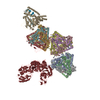
|
|---|---|
| 1 |
|
- Components
Components
| #1: Protein/peptide | Mass: 4050.441 Da / Num. of mol.: 10 / Source method: isolated from a natural source / Source: (natural)  Mammalian orthoreovirus 3 / References: UniProt: F1ARM5 Mammalian orthoreovirus 3 / References: UniProt: F1ARM5#2: Protein | Mass: 72228.719 Da / Num. of mol.: 10 / Source method: isolated from a natural source / Source: (natural)  Mammalian orthoreovirus 3 / References: UniProt: F1ARM5 Mammalian orthoreovirus 3 / References: UniProt: F1ARM5#3: Protein | | Mass: 143998.625 Da / Num. of mol.: 1 / Source method: isolated from a natural source / Source: (natural)  Mammalian orthoreovirus 3 Mammalian orthoreovirus 3References: UniProt: A0A0B5CUT9, mRNA (guanine-N7)-methyltransferase, mRNA guanylyltransferase #4: Chemical | ChemComp-MYR / Has ligand of interest | Y | Has protein modification | Y | |
|---|
-Experimental details
-Experiment
| Experiment | Method: ELECTRON MICROSCOPY |
|---|---|
| EM experiment | Aggregation state: PARTICLE / 3D reconstruction method: single particle reconstruction |
- Sample preparation
Sample preparation
| Component | Name: Mammalian orthoreovirus 3 Dearing / Type: VIRUS / Entity ID: #3 / Source: NATURAL |
|---|---|
| Source (natural) | Organism:  Mammalian orthoreovirus 3 Dearing Mammalian orthoreovirus 3 Dearing |
| Details of virus | Empty: NO / Enveloped: NO / Isolate: SEROTYPE / Type: VIRION |
| Buffer solution | pH: 7.4 |
| Specimen | Embedding applied: NO / Shadowing applied: NO / Staining applied: NO / Vitrification applied: YES |
| Vitrification | Cryogen name: ETHANE |
- Electron microscopy imaging
Electron microscopy imaging
| Experimental equipment |  Model: Titan Krios / Image courtesy: FEI Company |
|---|---|
| Microscopy | Model: FEI TITAN KRIOS |
| Electron gun | Electron source:  FIELD EMISSION GUN / Accelerating voltage: 300 kV / Illumination mode: FLOOD BEAM FIELD EMISSION GUN / Accelerating voltage: 300 kV / Illumination mode: FLOOD BEAM |
| Electron lens | Mode: BRIGHT FIELD |
| Image recording | Electron dose: 56 e/Å2 / Film or detector model: GATAN K2 SUMMIT (4k x 4k) |
- Processing
Processing
| CTF correction | Type: PHASE FLIPPING AND AMPLITUDE CORRECTION |
|---|---|
| 3D reconstruction | Resolution: 3.8 Å / Resolution method: FSC 0.143 CUT-OFF / Num. of particles: 61861 / Symmetry type: POINT |
| Refinement | Highest resolution: 3.8 Å |
 Movie
Movie Controller
Controller





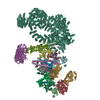
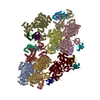


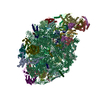
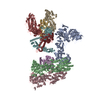
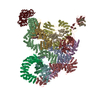

 PDBj
PDBj